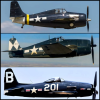Especially in the South pacific. Blazing.
You are using an out of date browser. It may not display this or other websites correctly.
You should upgrade or use an alternative browser.
You should upgrade or use an alternative browser.
American Aviation
- Thread starter Bootie
- Start date
- Joined
- Oct 11, 2010
- Messages
- 12,374
- Reaction score
- 6,928
- Age
- 60
Inspecting a B26 Marauder crash landed.


- Joined
- Oct 11, 2010
- Messages
- 12,374
- Reaction score
- 6,928
- Age
- 60
Avenger maintenance.


Amazing job of colorization.
Hard to believe really.
Hard to believe really.
- Joined
- Oct 11, 2010
- Messages
- 12,374
- Reaction score
- 6,928
- Age
- 60
Ha! For second there I didn't realize which side of the wall the firing was coming from towards the moving target.


Luv me the Bearcat. Was at an air show many years ago and they had one.
As it was getting ready for a fly by I could hear it a long time before I could see it!.
An engine sound like no other. And my God was it fast!.
-----
As it was getting ready for a fly by I could hear it a long time before I could see it!.
An engine sound like no other. And my God was it fast!.
-----
The XTB2D-1 was a late World War 2 prototype for a carrier based torpedo bomber. The Skypirate was to carry four torpedos on underwing pylons, had a powered defensive turret and wing mounted 20mm cannon. It was designed to operate strictly from the new larger carriers when ordered in 1943. It first flew in 1945, but was, like so many other fascinating prototypes of the late war, unnecessary for the war effort and cancelled after two prototypes were built. The aircraft featured a, for its day, MASSIVE 70 foot wingspan (21.34 meters) and was powered by the R-4360 driving a contra-rotating prop.
Looks a bit like a Stuka on steroids.
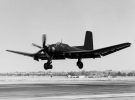
Looks a bit like a Stuka on steroids.

Last edited:
Had to look up contra-rotating...
This a good picture of the contra-rotating prop on the XTB2D-1:

"Contra-rotating propellers refers to an installation in which two propellers are attached to the same engine with one mounted immediately behind the other. The two propellers contra-rotate (rotate in opposite directions around the same axis) with engine power provided via a planetary gear or spur gear reduction gear box. Use of contra-rotating propellers recovers energy lost due to the motion of the air in the slipstream of the forward propeller and allows for an increase in power without a corresponding increase in propeller diameter. It will also help counter the torque effects of a high power piston engine."
This a good picture of the contra-rotating prop on the XTB2D-1:

"Contra-rotating propellers refers to an installation in which two propellers are attached to the same engine with one mounted immediately behind the other. The two propellers contra-rotate (rotate in opposite directions around the same axis) with engine power provided via a planetary gear or spur gear reduction gear box. Use of contra-rotating propellers recovers energy lost due to the motion of the air in the slipstream of the forward propeller and allows for an increase in power without a corresponding increase in propeller diameter. It will also help counter the torque effects of a high power piston engine."
The SB-17, also known as the B-17H, was developed as a variant of the iconic B-17 Flying Fortress and was primarily designed for air-sea rescue missions, gaining the nickname “Dumbo” due to its rescue role.
Heavy bombers, specifically modified to manage the lifeboat’s external load, carried this robust airborne lifeboat.
Intended for parachute drop during Dumbo missions, the SB-17 would drop a A-1 rescue boat, which was aimed to land near downed airmen.

Approximately 130 B-17Gs underwent modifications for USAAF air-sea rescue missions, which included equipping them with an airborne lifeboat.
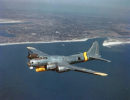
A U.S. Coast Guard Boeing PB-1G Flying Fortress search and rescue plane in flight. The USCG used 18 former USAAF SB-17G from 1945 to 1959.
The Higgins A-1 lifeboat was to be dropped by an SB-17 traveling at an airspeed of 120 miles per hour. The yellow-painted vessel was supplied with enough food, water and clothing for 12 survivors to last for about 20 days in the ocean. It was provided with sails kept relatively small so that inexpert operators could use them.
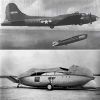
The SB-29 dropped the A3 boat as seen in the second picture.
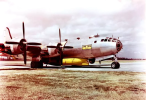
The success of the B-17H later referred to as the SB-17 Dumbo, prompted experimentation with a similar air-sea rescue aircraft based on the B-29 as early as 1944. The Superfortress’s extended range, increased lift capacity, and advanced features were all deemed improvements over the SB-17’s capabilities.
In 1949, a series of conversions for a select number of SB-29 aircraft commenced. According to recent research by Robert A. Mann, 25 such aircraft were primarily converted at Tinker Air Force Base.
Heavy bombers, specifically modified to manage the lifeboat’s external load, carried this robust airborne lifeboat.
Intended for parachute drop during Dumbo missions, the SB-17 would drop a A-1 rescue boat, which was aimed to land near downed airmen.

Approximately 130 B-17Gs underwent modifications for USAAF air-sea rescue missions, which included equipping them with an airborne lifeboat.

A U.S. Coast Guard Boeing PB-1G Flying Fortress search and rescue plane in flight. The USCG used 18 former USAAF SB-17G from 1945 to 1959.
The Higgins A-1 lifeboat was to be dropped by an SB-17 traveling at an airspeed of 120 miles per hour. The yellow-painted vessel was supplied with enough food, water and clothing for 12 survivors to last for about 20 days in the ocean. It was provided with sails kept relatively small so that inexpert operators could use them.

The SB-29 dropped the A3 boat as seen in the second picture.

The success of the B-17H later referred to as the SB-17 Dumbo, prompted experimentation with a similar air-sea rescue aircraft based on the B-29 as early as 1944. The Superfortress’s extended range, increased lift capacity, and advanced features were all deemed improvements over the SB-17’s capabilities.
In 1949, a series of conversions for a select number of SB-29 aircraft commenced. According to recent research by Robert A. Mann, 25 such aircraft were primarily converted at Tinker Air Force Base.
Curtiss SB2Cs (“Helldivers”) of VMSB-244 fly over Mindanao on a close air mission in support of Army ground troops, June 1945. Although not as common as the Dauntlesses and Corsairs, the two-seat SB2Cs packed plenty of precision punch.
















































































